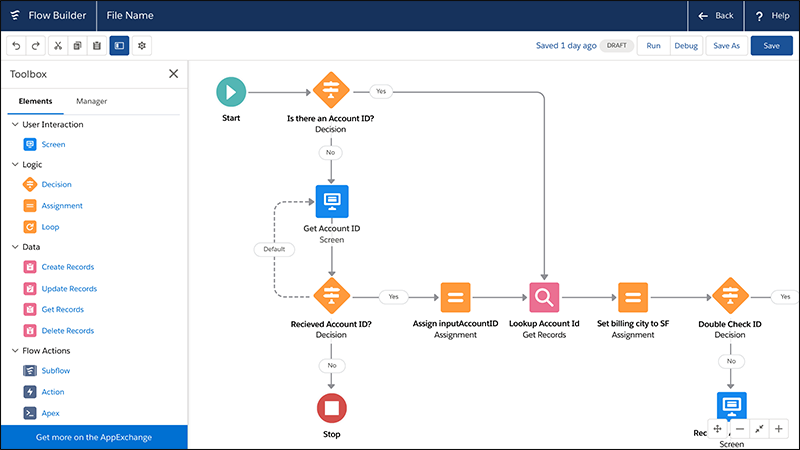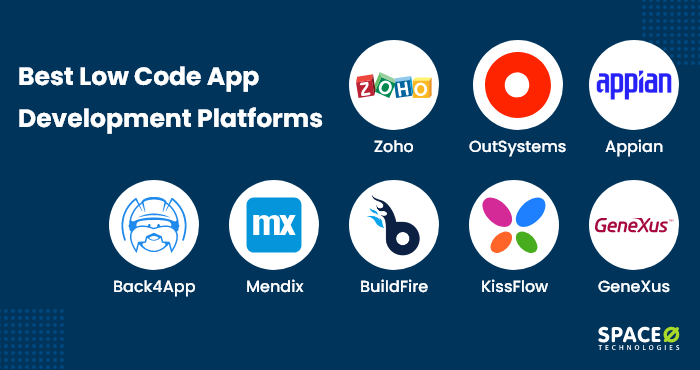Free Suggestions For Choosing Low-code platforms for application development
Free Suggestions For Choosing Low-code platforms for application development
Blog Article
Advantages Of Low-Code Application Development In Terms Of Integration Capabilities
Low-code applications offer significant advantages in terms of integration capabilities. They are essential for creating applications that can seamlessly integrate with diverse platforms and services. Here are a few of the principal benefits: Pre-built connectors and APIs.
A Variety of Connectors : Low-code platforms typically come with a vast collection of pre-built connectors for popular enterprise software (e.g. ERP CRM, databases and cloud services). This allows for easier integration with systems.
API Integration: A lot of Low-Code platforms include out-of box API integration capabilities that let developers quickly connect external services and data resources.
Easy to use:
Drag-and Drop Integration: Many integration tasks can be accomplished using drag-and drop interfaces. This allows developers and non-developers to build complicated integrations with minimal or no programming.
Visual Workflow Builders Visual Workflow Builders: These tools can be used for designing workflows, data flow, and integrations. They assist in understanding and setting up workflows more intuitively.
Standardized Integration Methods:
SOAP and restful services: Supporting web services standard protocols like REST and SOAP allows integration with a an array of software and systems.
OData Standards: OData standards permit the simple manipulation and accessibility of data across different platforms and applications.
Real-Time Data Synchronization:
Real-Time Integrations: Low-code platforms can handle the real-time synchronization of data among systems, applications as well as databases. This ensures that the data is always up-to date and consistent throughout an company.
Event-Driven architecture: Certain platforms support event driven architectures. This allows apps to react to events in real time, which is essential for interactive and dynamic apps.
Legacy System Integration:
Bridging old Systems and new Systems Low-code platforms often provide tools to integrate with existing legacy systems. This allows organizations to modernize their IT Infrastructure without having to overhaul the current systems.
Data Migration Tools: These built-in instruments to migrate data facilitate the transfer of old systems to new applications built using low-code platforms.
Integration of Third Party Services:
Cloud Services: Seamless Integration with Cloud Services such as AWS Azure Google Cloud and Google Cloud makes it easy to deploy applications.
Business Applications Integration: Low-code platforms can be integrated with various business applications such as Salesforce, SAP and Microsoft Dynamics. This allows for a seamless workflow between the business tasks.
Simple Data Management
Unified Data Models - Certain low code platforms offer unification of data models that simplifies data management and integration between different systems.
Data Connectors: Data connectors that are pre-configured to allow easy access to and manipulation of data derived from different sources.
Security and Compliance
Secure Integrations: Low code platforms ensure that integrations conform to security protocols and standard safeguarding data while in transportation as well as during rest.
Compliance Features: These platforms typically have features that assure that integrations are in compliance with the requirements of regulatory agencies, like GDPR or HIPAA. This can provide peace of mind for businesses that handle sensitive information.
Extensibility:
Low-code platforms enable the use of custom scripts and code to meet more complex integration needs. This flexibility is available without compromising the ease of use.
Plug-in Ecosystems: A plug-in ecosystem can be used to expand the integration capability and permit users to expand the functionality in the event of need.
Overall, low-code development platforms offer powerful integration capabilities that make them an excellent device for developing interconnected and efficient applications. They facilitate the process of connecting disparate systems, enhance data flow and allow businesses to adopt new technologies while using existing ones. View the top more help for Low-code Platform for application development for website recommendations including no code platforms, app development platform, lowcode no code, microsoft azure sql, no code platforms, rapid action development, paas service, rapid action development, database in azure, microsoft azure sql and more.
Benefits Low-Code Apps In Safety And Governance
Low-code applications offer a number of advantages in terms of security and governance. These are essential for ensuring that applications are compliant and secure. They also ensure that they are well-managed throughout their lifecycle. Here are a few key advantages.
Unified Management Console: A low-code platform often provides a centralized dashboard where administrators can monitor and manage all apps, ensuring consistency governance across the organisation.
Role-Based Access Control: These platforms offer robust role-based access control which allows administrators to set guidelines and then enforce the rules. This allows only authorized users to alter or access specific areas of the program.
Compliance and Regulatory Applicability:
A majority of low-code platforms include compliance features. They are designed to comply with industry standards and regulations such as GDPR and HIPAA. These platforms have frameworks and tools to make sure that the application is in line with these requirements.
Audit trails and logging Audit trails that are comprehensive and logging are usually combined. This lets organizations track and monitor changes and access, as well as ensure compliance with internal regulations as well as external regulations.
Improve Security Measures
Data encryption. Low code platforms typically offer built-in encrypted data when in transit as well as when at rest. This helps protect sensitive information.
Security Certifications – Many lowcode providers have security certifications such as ISO 27001 (or SOC2) that demonstrate their adherence to the highest security standards. Users can be assured that these providers adhere to the standards.
Automated security updates
Regular Updates and Patches Low code platforms typically are equipped to handle security updates and patches regularly. This ensures that applications are protected against the most recent security threats, and without developers having to manually alter their settings.
Security Monitoring: Constant security monitoring tools can be used to send real-time notifications and information on security problems.
Data Governance
Data Access Policies: These tools allow organizations to define as well as enforce and monitor data policies. This ensures that information is only available to authorized users and that they are used correctly.
Data Masking, anonymization, and Anonymization Tools: These tools assist to protect sensitive personal information and are particularly useful in testing environments.
Consistent application lifecycle management:
Pipelines for development and deployment Lowcode platforms usually provide integrated development-and-deployment pipelines with security checks. They ensure protection throughout the lifecycle of the application.
Version Control - The integrated version control helps track modifications to applications and allow users to revert them when needed. They also ensure the integrity and quality of the application.
Authorization and Authentication of Users:
Single Sign-On (SSO) Single sign-on support as well as other advanced authentication techniques simplify management of users and improves security.
Multi-Factor Authentication - Many platforms can support multi-factor Authentication that adds an extra layer to security when accessing apps.
Policy enforcement and Compliance Monitoring:
Low-code platforms are usually designed with policies that are pre-defined to assist companies in implementing security and governance policies swiftly.
Tools for Monitoring Compliance: These tools provide continuous monitoring, reports and analysis of compliance status. It's easier to identify possible issues and take proactive actions.
Integration into Existing Security Infrastructure
Seamless Integration: Low-code platforms are designed to work seamlessly with existing security infrastructure and tools, such as identity management solutions, SIEMs (Security Information and Event Management Solutions), and firewalls.
API Security API Security: API security features are built-in to ensure integrations with external systems, securing information and ensuring integrity of applications.
Best practices and training:
Guided Best Practices : A lot of platforms offer guidelines and best practices to assist non-developers comply with security standards.
Security Training: Certain providers of low-code software offer courses and other resources for security to educate users about how to design and develop secure applications.
The governance and security features of low-code apps ensure they are developed and maintained in a regulated and compliant way. These platforms provide all the tools and frameworks needed to protect sensitive data and enforce policies, while ensuring regulatory compliance. Follow the top Legacy application modernization with Low-code for more advice including push notifications android, cross platform mobile app development, develop web app, push notifications android, develop cross platform mobile app, stored sql procedures, develop web application, application development platforms, low code development platforms, azure sql server and more.
Advantages Of Low Code Application Development With Limitations And Customization
Low-code application development offers a balanced approach that provides significant advantages in terms of solving limitations and allowing customisation. Here are a few main benefits:Handling limitations:
The Challenge of Overcoming Complexity
Simplified Development: Low-code platforms cut down on the complexity of development by providing templates and components pre-built for you, enabling rapid development and deployment for complex applications.
Many platforms have wizards and workflows that are guided to assist developers in navigating complicated processes. These tools minimize the chance of making mistakes, and help ensure uniformity.
Scalability Solutions:
Built-in Scalability: Low code platforms come with a variety of features that allow for an architectural design that is scalable, allowing applications to cope with increased loads without major redevelopment.
Performance Monitoring: Using tools for performance monitoring optimization, tuning and monitoring help applications scale efficiently.
Security and Compliance
Integrated security features Low-code platform come with built-in measures of security such as encryption. Access control that is based on roles and automated compliance checks address the most frequent security issues.
Regular Updates: Platforms frequently change their security protocols and compliance policies. This helps ensure that applications are secure from new threats.
Customization:
Extensibility:
Low-code Platforms Support Custom Code: These platforms allow for the integration and usage of custom code.
Custom Modules and Plugins: Developers have the option to create customized modules or plugins to customize specific functionality to fit unique business needs.
APIs Integration:
API Support: Full API support permits seamless integration of other systems and services. This allows for the ability to customize and connect.
Third-Party Services: Low-code platforms typically offer pre-built connectors for popular third-party services, which makes it easier to customize and integrate applications.
Flexible UI/UX:
User-friendly interfaces that can be customized: Users are able to modify and create their own user interfaces that will give an experience that is more customized.
Responsive Design: Built-in responsive design capabilities ensure that applications can be adapted to different screens and devices.
The process of customizing Business Logic is easy:
Visual Workflow Builders Visual tools for creating and customizing workflows as well as business logic let developers create complex, tailored processes without extensive code.
Conditional Logic & scripting : Platforms allow conditional logic and custom scripting in order to meet particular business rules.
Data Management:
Custom Data Modeling: Designers develop custom models to meet specific requirements for the particular application. They can tailor data handling to the business's needs.
Advanced Data Processing Integration and advanced data handling tools allow for customisation of the data analysis process and utilization in the program.
Balance Customization and Limitations:
Frameworks and Standards
Low-code platforms are compliant with the industry standard and best practice. This ensures high-quality and secure applications.
Governance Frameworks. The built-in governance frameworks ensure that customizations will not affect the security, compliance or integrity of the application.
Feedback and iterative development:
Rapid Prototyping: The capability to rapidly prototype and test modifications allows developers to modify their designs based on feedback from users improving the app to better satisfy the user's needs.
Continuous Improvement: Low-code platforms allow constant improvement, allowing constant customization and enhancements when business requirements change.
User Empowerment
Enabling Citizen Developers to Develop by allowing non-developers to make customizations through intuitive user interfaces, platforms that do not require code expand the number of users who can improve and customize applications.
Training and Support Many platforms provide comprehensive training and resources to support users as they customize their applications, without impacting the stability or performance of the application.
Overall, low code application development provides a robust framework that can address the limitations and provide ample options for customization. This balance lets businesses develop and maintain functional applications that are tailored to their specific needs, while maintaining high standards for quality, security and scaling.